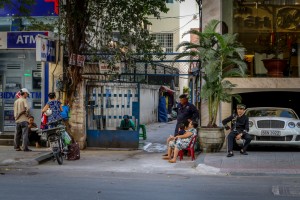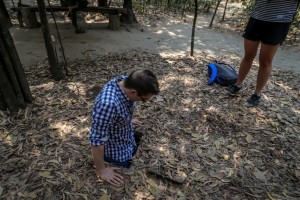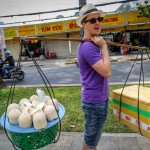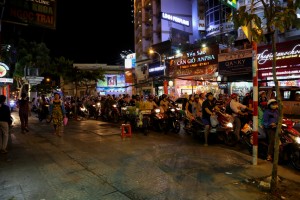We left Central Vietnam after almost a week to head to the very south of the country for our last destination: Saigon. Once again we decided to travel by land and took an overnight train. The reunification express should bring us on leisurely 18hrs ride over approx. 900km to our destination (in the end it took us a few hrs more – but whats a 1-2 hrs delay on a 1.5day trip?). This time we were not as lucky as the last time we travellede by train. Our driver from Hoi An to Da Nang train station arrived late for pick-up, smelled like he drank way too much alcohol to drive and our heart rates rocketed a few times caused by his fancy overtaking maneuvers. After surviving the transfer we arrived at an overcrowded train station with barely a place to sit while waiting for the train. We could finally board our coach at around 23:00. The cabin we would spend the next day was by far below our expectation after our first pleasant experience from Hanoi to Hue. The first welcome greetings were the dirty feet from an old local man laying in the cabin and the presence of some rubbish and cigarette smell. There was no bedlinen provided and one of our matresses was beautifully stained and looked like our predecessor had had a pee or two on it. Fortunately we could hide in our clean thin silk sleeping bags so we tried to get some sleep while people hopped on and off the train throughout the night.
We got into Saigon at around 17:00 the next day. On our journey we already noticed that the environment has changed. Nature no longer presented itself in the lush greens known from the north. The clima has changed to tropcial with 30degrees+ and endless blue skies (dry season in the south from Dec to Apr). We shared a cab to the city center with a retired American whom we got to know on the train and who lives in Vietnam for 14 years due to his affinity to drugs (he explained to us, that it’s much easier to smoke pot (marijuana) in Vietnam than in the States – we always thought South East Asian countries are very strict when it comes to drug abuse…whatever).
We realized from the very minute we got into town: Saigon is different. Although it’s the same country, it has little to do with what we saw so far. Longterm international influence from French and American times is visible in every corner (bakeries, skyscrapers, huge LED advertisement screens, McDonalds, Starbucks…). The economy seemed to soar within the past years whilst the entire infrastructure (and unfortunaltely some people) did not keep up with the pace. Saigon is home to over 7 Mio. people (almost as many as Switzerland) cramped on an area more than 20 times smaller. There’s no mrt system or monorail available. We thought Hanoi’s bad, Saigon is worse. Traffic is horrible, air pollution massive and noise abundant. As we browsed around the city we noticed a huge disparity. From lonely old war veterans wounded and left with no legs sitting in city parks to high heeled teenies browsing on their latest iPhones. From grandparents feeding their grandchilder on the str eets as child’s parents are busy trying to earn a few dollars to impatient businessmen honking in half a million dollar Bentley because they are stuck in traffic with all those motorcycles. This huge contradiction got us thinking. Are those veterans who once led this country to independence still able to take part in today’s rushing economy? Where is this gonna end up? Can this city ever „breathe-out“?
eets as child’s parents are busy trying to earn a few dollars to impatient businessmen honking in half a million dollar Bentley because they are stuck in traffic with all those motorcycles. This huge contradiction got us thinking. Are those veterans who once led this country to independence still able to take part in today’s rushing economy? Where is this gonna end up? Can this city ever „breathe-out“?
As the painful history of this country during numerous wars is incarnated in nearly every sight we visited in the past two weeks: The war remnants museum Saigon beats it all. This is truly a must visit if you would ever come by Saigon and it is indeed an eye-opener. But be prepared: it’s heavy. Very heavy. The musuem mainly displays photos and some relicts (weapons and tools of soldiers) from the American war between 1955 to 1975. As we browsed around the exhibition (in complete silence) we realized how deep the scares of this war must have been (and still are). The war photographers captured moments when entire civilian villages were ravished by Americans, children and pregnant women were massacred without a reason, old men were dragged to death by american vehicles and victims of napalm bombs or missborn babies with the worst degree of disability you can imagine caused by the use of Agent Orange to defoliate to forest where guerilla fighters hide themselves.
Another impressive site that we have visited was the Cu Chi tunnel system. With its 220km length in total, it is a complex tunnel system that was important in the war against Americans. The Viet Cong (so to say the communist soldiers) spent years to build the three layered tunnel system: first layer 3 meter below earth surface, second layer 5m, third layer 8-10m. They used bare hands to dig the whole system! Many technics were used to hide their exis tence from the Americans, such as cooking only in the morning and evening when it was usually foggy, so that their enemies could not distinguish between smoke and fog. We could go down to the tunnel system and after 20m (Roman did 40m) I have had enough. It was narrow and dark. It is hard to imagine that the Viet Cong had to live downthere for days. When the Americans were not firing them, the soldiers could come out for some fresh air in the evening. Its amazing to see how they dealt with scarce ressources and recycled things. The soldiers made their own slippers out of old tyres which could last 8-10 y
tence from the Americans, such as cooking only in the morning and evening when it was usually foggy, so that their enemies could not distinguish between smoke and fog. We could go down to the tunnel system and after 20m (Roman did 40m) I have had enough. It was narrow and dark. It is hard to imagine that the Viet Cong had to live downthere for days. When the Americans were not firing them, the soldiers could come out for some fresh air in the evening. Its amazing to see how they dealt with scarce ressources and recycled things. The soldiers made their own slippers out of old tyres which could last 8-10 y ears. The slippers could be worn in two manners, one normal way and the other manner is to leave „backward prints“ eventhough when he/she is walking forward to disguise from their enemies. They also dissambled unexploded American bombs and constructed landmines to use against their enemies.
ears. The slippers could be worn in two manners, one normal way and the other manner is to leave „backward prints“ eventhough when he/she is walking forward to disguise from their enemies. They also dissambled unexploded American bombs and constructed landmines to use against their enemies.
After two weeks in Vietnam, from north to south, we have seen many sides of this beautiful country: Its touching history, endless rice fields, hardworkin g people and delicous food. Two weeks have been nice to get a first glance at this country, but its barely enought to discover even the so called „top-spots“. Since we choose to travel from the very northern to the nearly southermost point we got a nice overview of the contrast in this country, but to avoid rushing thourgh and cutting out some of the spots we would recommend anyone visiting Vietnam to plan at least double of the time we allowed ourselfes. Vietnam is not for the faint-hearted nor would we recommend it first first-time-asia travellers: be prepared to be confronted with the cruelty of war, endless hard bargains, huge cultural differences and a sometimes chaotic system. The Vietnamese have proved that their independence is a hard-fought victory with blood, sweat, intelligence and determination and we re glad we got in touch with this culture. We (and one of us a bit impatiently) are now looking foreward to travel further to Malyasia for some festives, food and family gathering during upcoming Chinese New Year.
g people and delicous food. Two weeks have been nice to get a first glance at this country, but its barely enought to discover even the so called „top-spots“. Since we choose to travel from the very northern to the nearly southermost point we got a nice overview of the contrast in this country, but to avoid rushing thourgh and cutting out some of the spots we would recommend anyone visiting Vietnam to plan at least double of the time we allowed ourselfes. Vietnam is not for the faint-hearted nor would we recommend it first first-time-asia travellers: be prepared to be confronted with the cruelty of war, endless hard bargains, huge cultural differences and a sometimes chaotic system. The Vietnamese have proved that their independence is a hard-fought victory with blood, sweat, intelligence and determination and we re glad we got in touch with this culture. We (and one of us a bit impatiently) are now looking foreward to travel further to Malyasia for some festives, food and family gathering during upcoming Chinese New Year.

